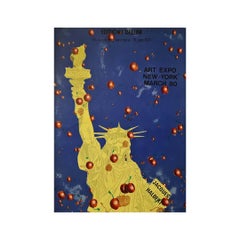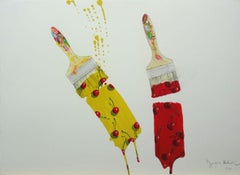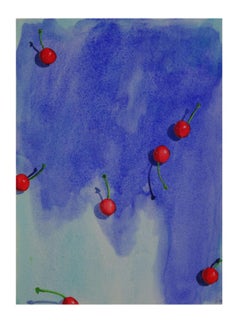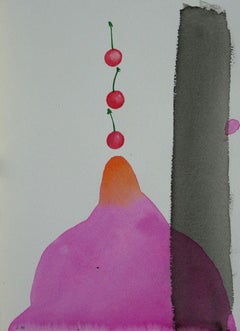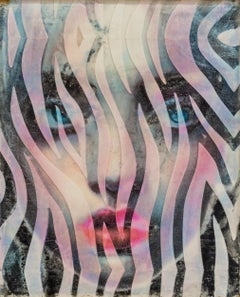Jacques Halbert Art
to
10
5
5
3
7
Overall Height
to
Overall Width
to
3
2
2
2
2
2
1
1
1
1
1
1
1
1
1
1
1
1
1
1
2
8
2
10
6,910
3,230
2,514
1,217
8
5
5
3
2
Artist: Jacques Halbert
1980 Original poster of Jacques Halbert for an exhibition in New York
By Jacques Halbert
Located in PARIS, FR
Beautiful poster of Jacques Halbert in New York. Jacques Halbert is a French contemporary artist. His plastic work is almost exclusively and invariably reduced to applying one or mor...
Category
1980s Jacques Halbert Art
Materials
Lithograph, Paper
Who’s Afraid of Yellow and Red
By Jacques Halbert
Located in Saint Ouen, FR
Jacques Halbert, born in 1955 in Bourgueil, is a contemporary French artist.
He attended the Brassart school then the École des Beaux-Arts in Bourges. In the 80s, he moved to the Un...
Category
Early 2000s Jacques Halbert Art
Materials
Acrylic
Blue Velvet
By Jacques Halbert
Located in Saint Ouen, FR
Jacques Halbert, born in 1955 in Bourgueil, is a contemporary French artist.
He attended the Brassart school then the École des Beaux-Arts in Bourges. In the 80s, he moved to the Un...
Category
2010s Jacques Halbert Art
Materials
Watercolor
Langue jongleuse
By Jacques Halbert
Located in Saint Ouen, FR
Jacques Halbert, born in 1955 in Bourgueil, is a contemporary French artist.
He attended the Brassart school then the École des Beaux-Arts in Bourges. In the 80s, he moved to the Un...
Category
2010s Jacques Halbert Art
Materials
Watercolor
LOVE
By Jacques Halbert
Located in Saint Ouen, FR
Jacques Halbert, born in 1955 in Bourgueil, is a contemporary French artist.
He attended the Brassart school then the École des Beaux-Arts in Bourges. In the 80s, he moved to the Un...
Category
Early 2000s Jacques Halbert Art
Materials
Watercolor
Tropic of Cancer
By Jacques Halbert
Located in Saint Ouen, FR
Jacques Halbert, born in 1955 in Bourgueil, is a contemporary French artist.
He attended the Brassart school then the École des Beaux-Arts in Bourges. In the 80s, he moved to the Un...
Category
Early 2000s Jacques Halbert Art
Materials
Acrylic
Liberty
By Jacques Halbert
Located in Saint Ouen, FR
Jacques Halbert, born in 1955 in Bourgueil, is a contemporary French artist.
He attended the Brassart school then the École des Beaux-Arts in Bourges. In the 80s, he moved to the Un...
Category
1980s Jacques Halbert Art
Materials
Lithograph
Saint Glinglin
By Jacques Halbert
Located in Saint Ouen, FR
Jacques Halbert, born in 1955 in Bourgueil, is a contemporary French artist.
He attended the Brassart school then the École des Beaux-Arts in Bourges. In the 80s, he moved to the Un...
Category
Early 2000s Jacques Halbert Art
Materials
Acrylic
L’écume des cerises
By Jacques Halbert
Located in Saint Ouen, FR
Jacques Halbert, born in 1955 in Bourgueil, is a contemporary French artist.
He attended the Brassart school then the École des Beaux-Arts in Bourges. In the 80s, he moved to the Un...
Category
Early 2000s Jacques Halbert Art
Materials
Acrylic
White Brush stroke
By Jacques Halbert
Located in Saint Ouen, FR
Jacques Halbert, born in 1955 in Bourgueil, is a contemporary French artist.
He attended the Brassart school then the École des Beaux-Arts in Bourges. In the 80s, he moved to the Un...
Category
Early 2000s Jacques Halbert Art
Materials
Acrylic
Related Items
INTO THE WILD - Impasto Painting - A.I. Woman in Wooden Frame
By Matthew Dutton
Located in Signal Mountain, TN
Disappearing back into the shadows, she leans into the nature of a new existence, wild and free but still so alone..
In INTO THE WILD, Matthew Dutton creates a new work out of conte...
Category
2010s Contemporary Jacques Halbert Art
Materials
Plaster, Wood, Ink, Watercolor
H 7 in W 9 in D 0.5 in
The Abduction of the Sabine Women , a Renaissance drawing by Biagio Pupini
Located in PARIS, FR
This vigorous drawing has long been attributed to Polidoro da Caravaggio: The Abduction of the Sabine Women is one of the scenes that Polidoro depicted between 1525 and 1527 on the façade of the Milesi Palazzo in Rome. However, the proximity to another drawing inspired by this same façade, kept at the Ecole des Beaux-Arts, and to other drawings inspired by Polidoro kept at the Musée du Louvre, leads us to propose an attribution to Biagio Pupini, a Bolognese artist whose life remains barely known, despite the abundant number of drawings attributed to him.
1. Biagio Pupini, a Bolognese artist in the light of the Roman Renaissance
The early life of Biagio Pupini, an important figure of the first half of the Cinquecento in Bologna - Vasari mentions him several times - is still poorly known. Neither his date of birth (probably around 1490-1495) nor his training are known. He is said to have been a pupil of Francesco Francia (1450 - 1517) and his name appears for the first time in 1511 in a contract with the painter Bagnacavallo (c. 1484 - 1542) for the frescoes of a church in Faenza. He then collaborated with Girolamo da Carpi, at San Michele in Bosco and at the villa of Belriguardo.
He must have gone to Rome for the first time with Bagnacavallo between 1511 and 1519. There he discovered the art of Raphael, with whom he might have worked, and that of Polidoro da Caravaggio. This first visit, and those that followed, were the occasion for an intense study of ancient and modern art, as illustrated by his abundant graphic production.
Polidoro da Caravaggio had a particular influence on the technique adopted by Pupini. Executed on coloured paper, his drawings generally combine pen, brown ink and wash with abundant highlights of white gouache, as in the drawing presented here.
2. The Abduction of the Sabine Women
Our drawing is an adaptation of a fresco painted between 1525 and 1527 by Polidoro da Caravaggio on the façade of the Milesi Palace in Rome. These painted façades were very famous from the moment they were painted and inspired many artists during their stay in Rome. These frescoes are now very deteriorated and difficult to see, as the palace is in a rather narrow street.
The episode of the abduction of the Sabine women (which appears in the centre of the photo above) is a historical theme that goes back to the origins of Rome and is recounted both by Titus Livius (Ab Urbe condita I,13), by Ovid (Fasti III, 199-228) and by Plutarch (II, Romulus 14-19). After killing his twin brother Romus, Romulus populates the city of Rome by opening it up to refugees and brigands and finds himself with an excess of men. Because of their reputation, none of the inhabitants of the neighbouring cities want to give them their daughters in marriage. The Romans then decide to invite their Sabine neighbours to a great feast during which they slaughter the Sabines and kidnap their daughters.
The engraving made by Giovanni Battista Gallestruzzi (1618 - 1677) around 1656-1658 gives us a good understanding of the Polidoro fresco, allowing us to see how Biagio Pupini reworked the scene to extract this dynamic group.
With a remarkable economy of means, Biagio Pupini takes over the left-hand side of the fresco and depicts in a very dense space two main groups, each consisting of a Roman and a Sabine, completed by a group of three soldiers in the background (which seems to differ quite significantly from Polidoro's composition).
The balance of the drawing is based on a very strongly structured composition. The drawing is organised around a median vertical axis, which runs along both the elbow of the kidnapped Sabine on the left and the foot of her captor, and the two main diagonals, reinforced by four secondary diagonals. This diamond-shaped structure creates an extremely dynamic space, in which centripetal movements (the legs of the Sabine on the right, the arm of the soldier on the back at the top right) and centrifugal movements (the arm of the kidnapper on the left and the legs of the Sabine he is carrying away, the arm of the Sabine on the right) oppose each other, giving the drawing the appearance of a whirlpool around a central point of support situated slightly to the left of the navel of the kidnapper on the right.
3. Polidoro da Caravaggio, and the decorations of Roman palaces
Polidoro da Caravaggio was a paradoxical artist who entered Raphael's (1483 - 1520) workshop at a very young age, when he oversaw the Lodges in the Vatican. Most of his Roman work, which was the peak of his career, has disappeared, as he specialised in facade painting, and yet these paintings, which are eminently visible in urban spaces, have influenced generations of artists who copied them abundantly during their visits to Rome.
Polidoro Caldara was born in Caravaggio around 1495-1500 (the birthplace of Michelangelo Merisi, known as Caravaggio, who was born there in 1571), some forty kilometres east of Milan. According to Vasari, he arrived as a mason on the Vatican's construction site and joined Raphael's workshop around 1517 (at the age of eighteen according to Vasari). This integration would have allowed Polidoro to work not only on the frescoes of the Lodges, but also on some of the frescoes of the Chambers, as well as on the flat of Cardinal Bibiena in the Vatican.
After Raphael's death in 1520, Polidoro worked first with Perin del Vaga before joining forces with Maturino of Florence (1490 - 1528), whom he had also known in Raphael's workshop. Together they specialised in the painting of palace façades. They were to produce some forty façades decorated with grisaille paintings imitating antique bas-reliefs.
The Sack of Rome in 1527, during which his friend Maturino was killed, led Polidoro to flee first to Naples (where he had already stayed in 1523), then to Messina. It was while he was preparing his return to the peninsula that he was murdered by one of his assistants, Tonno Calabrese, in 1543.
In his Vite, Vasari celebrated Polidoro as the greatest façade decorator of his time, noting that "there is no flat, palace, garden or villa in Rome that does not contain a work by Polidoro". Polidoro's facade decorations, most of which have disappeared as they were displayed in the open air, constitute the most important lost chapter of Roman art of the Cinquecento. The few surviving drawings of the painter can, however, give an idea of the original appearance of his murals and show that he was an artist of remarkable and highly original genius.
4. The façade of the Milesi Palace
Giovanni Antonio Milesi, who commissioned this palace, located not far from the Tiber, north of Piazza Navona, was a native of the Bergamo area, like Polidoro, with whom he maintained close friendly ties. Executed in the last years before the Sack of Rome, around 1526-1527, the decoration of Palazzo Milesi is considered Polidoro's greatest decorative success.
An engraving by Ernesto Maccari made at the end of the nineteenth century allows us to understand the general balance of this façade, which was still well preserved at the time. The frescoes were not entirely monochrome, but alternated elements in chiaroscuro simulating marble bas-reliefs and those in ochre simulating bronze and gold vases...
Category
16th Century Old Masters Jacques Halbert Art
Materials
Ink, Gouache, Pen
Large Gouache Original Painting Mother & Daughter Sandu Liberman Israeli Judaica
By Sandu Liberman
Located in Surfside, FL
framed 36 X 28 board 30 X 21.75
Sandu Liberman (Romanian-Israeli) was born in Yasi, Romania in 1923. between 1946 and 1953 he took part in the state art shows in Bucharest. in 1952 ...
Category
20th Century Modern Jacques Halbert Art
Materials
Gouache, Paper
Keith Haring Paradise Garage Exhibit Poster 'Keith Haring Jeffrey Deitch'
By Keith Haring
Located in NEW YORK, NY
Rare vintage Keith Haring exhibition poster published on the occasion of:
‘Paradise Garage: Keith Haring and Music,
December 14, 2000-February 10, 2001, Deitch Projects, 18 Wooster ...
Category
1980s Pop Art Jacques Halbert Art
Materials
Paper, Lithograph, Offset
Tomás Sánchez ( 1948 ) – Orilla - hand-signed lithograph on Arches paper – 1994
By Tomás Sánchez
Located in Varese, IT
color lithograph on Arches paper, edited in 1994
Limited Edition of 130 copies
signed and dated in pencil by artist in lower right and numbered 84/130 lower left
Paper size: 100 x 70...
Category
1990s Surrealist Jacques Halbert Art
Materials
Paper, Lithograph
Joan Miró - MARAVILLAS CON VARIACIONES... Lithograph Contemporary Art Abstract
By Joan Miró
Located in Madrid, Madrid
Joan Miró - Maravillas con variaciones acrósticas en el jardín de Miró X
Date of creation: 1975
Medium: Lithograph on Gvarro paper
Edition: 1500
Size: 49,5 x 35,5 cm
Condition: In ve...
Category
1970s Abstract Jacques Halbert Art
Materials
Paper, Lithograph
H 19.49 in W 13.98 in D 0.08 in
René Magritte - LE BEAU MONDE- Limited Lithograph Surrealism French Contemporary
By (after) René Magritte
Located in Madrid, Madrid
René Magritte - LE BEAU MONDE, 1962 (THE BEAUTIFUL WORLD)
Date of creation: 2010
Medium: Lithograph on BFK Rives Paper
Edition number: 154/275
Size: 60 x 45 cm
Condition: In very goo...
Category
Mid-20th Century Surrealist Jacques Halbert Art
Materials
Paper, Lithograph
Free Shipping
H 17.72 in W 23.63 in
Untitled, 1965
By Oswaldo Vigas
Located in Palm Beach, FL
Predominantly recognized as a self-taught painter, he also worked in architectural murals, sculptures, ceramics, prints and drawings.
Vigas is one...
Category
1960s Cubist Jacques Halbert Art
Materials
Canvas, Oil, Gouache, Board
Altitudes /// Abstract Expressionism Helen Frankenthaler Female Post-War Modern
By Helen Frankenthaler
Located in Saint Augustine, FL
Artist: Helen Frankenthaler (American, 1928-2011)
Title: "Altitudes"
*Signed, dated, and numbered by Frankenthaler in pencil lower right
Year: 1978
Medium: Original Lithograph on light yellow-pink J.B. Green Hayle Mill Bodleian handmade paper
Limited edition: 29/42
Printer: Bill Goldston and John A. Lund of Universal Limited Art Editions, West Islip, NY
Publisher: Universal Limited Art Editions, West Islip, NY
Reference: "Frankenthaler: A Catalogue Raisonné - Prints 1961-1994" - Harrison No. 72, page 264, 268-270; "ULAE" - Sparks No. 33, page 88, 323; Clark No. 67; Williams No. 67
Sheet size (irregular margins): 22.25" x 30.88"
Condition: Remnants of previous mounting tape on verso. In excellent condition with strong colors
Very rare
Notes:
Provenance: private collection - New York, NY; private collection - notable fashion illustrator Jay Hyde, Crawford, New York, NY; acquired from an art gallery in New York, NY; likely acquired directly from the publisher Universal Limited Art Editions, West Islip, NY. Lithograph drawn with tusche wash. Printed in two colors from two stones: red and green. Universal Limited Art Editions chop mark/blind stamp lower right.
"Frankenthaler: A Catalogue Raisonné - Prints 1961-1994" - Harrison - "Frankenthaler carefully chose a European handmade paper that would add another color and texture to the print" ... "By contrast, in "Altitudes", the artist created a bleed image so that the sheet of paper is smaller than the stone's image and the large red tusche wash sweeps across the surface of the yellow-pink J.B. Green Hayle Mill Bodleian paper, becoming warmed and enhanced by its color and texture."
"Universal Limited Art Editions - A History and Catalogue: The First Twenty-Five Years" - Sparks - "In "Bronze Smoke" (cat. no. 32), "Altitudes" (cat. no. 33), and "Door" (cat. no. 34), minimal compositions were replaced by fields of drifting, multilayered color, as rich and satisfying as her work on a much grander scale."
Biography:
Frankenthaler was an American abstract expressionist painter. She was a major contributor to the history of postwar American painting...
Category
1970s Abstract Expressionist Jacques Halbert Art
Materials
Handmade Paper, Lithograph
Gerald Leslie Brockhurst (1890-1978) – Ideal Head – Signed Lithograph - ca. 1925
By Gerald Leslie Brockhurst
Located in Meinisberg, CH
Gerald Leslie Brockhurst
(1890-1978)
The Ideal Head (Portrait of Fabian)
• Probably a Lithograph, sheet ca. 58 x 44 cm (v. thick paper/thin card)
• Plate size ca. 41 x 31 cm
• Imag...
Category
Early 20th Century Naturalistic Jacques Halbert Art
Materials
Paper, Lithograph
Free Shipping
H 22.84 in W 17.33 in
Les Essencies de la Terra - 1968 Lithograph Signed & Numbered on Japon Nacre
By Joan Miró
Located in Rancho Santa Fe, CA
A wonderful 1968 lithograph by Joan Miro titled “Les Essencies de la Terra”
Signed & Numbered on Japon Nacre paper
Framed dimensions (approximate) 32 x 26 inches
Joan Miró (1893-19...
Category
1960s Abstract Jacques Halbert Art
Materials
Archival Paper, Black and White, Lithograph
Joan Miro 208 Original lithography limited edition painting
By Joan Miró
Located in CORAL GABLES - MIAMI, FL
Joan Miro Original lithography limited edition painting
"PER UN TEATRE A CALALUNYA"
Original graphic work of the Spanish master Joan MIRO.
Lithography
Edition limited to 50 copies. ...
Category
Late 20th Century Abstract Jacques Halbert Art
Materials
Paper, Lithograph
Jacques Halbert art for sale on 1stDibs.
Find a wide variety of authentic Jacques Halbert art available for sale on 1stDibs. If you’re browsing the collection of art to introduce a pop of color in a neutral corner of your living room or bedroom, you can find work that includes elements of purple, blue and other colors. You can also browse by medium to find art by Jacques Halbert in paint, acrylic paint, synthetic resin paint and more. Not every interior allows for large Jacques Halbert art, so small editions measuring 10 inches across are available. Customers who are interested in this artist might also find the work of Michael Eggleston, Aly Cairo, and Claudio Benghi. Jacques Halbert art prices can differ depending upon medium, time period and other attributes. On 1stDibs, the price for these items starts at $653 and tops out at $3,157, while the average work can sell for $925.
